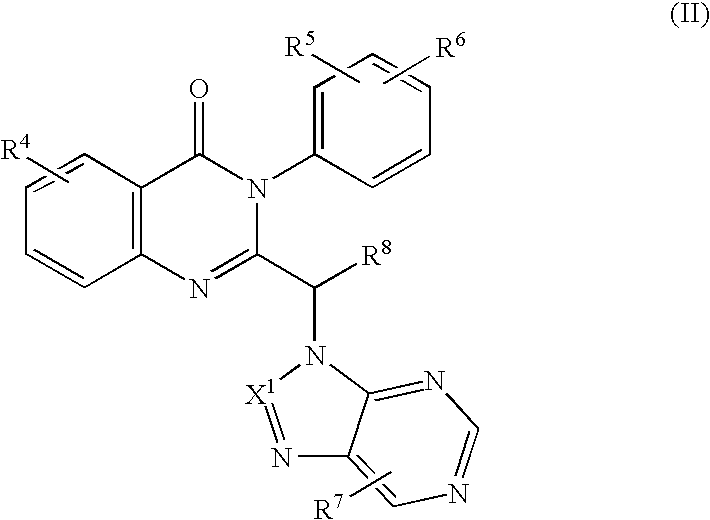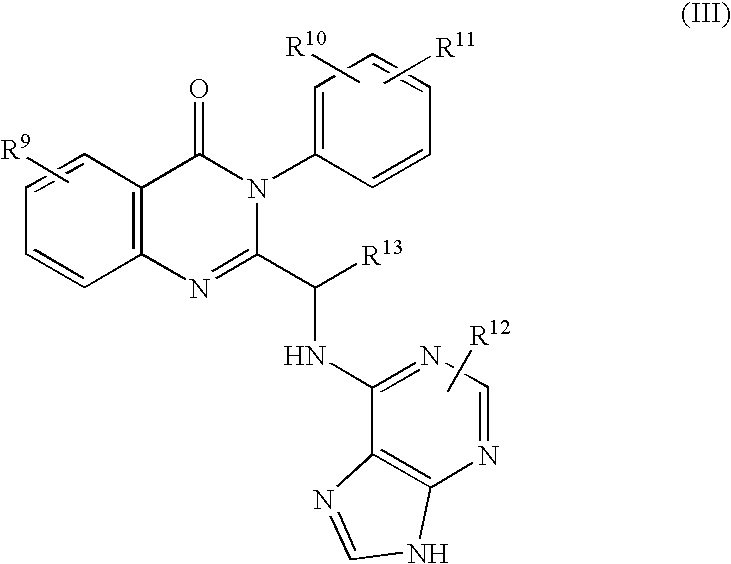Methods for inhibiting angiogenesis
a technology of angiogenesis and angiogenesis, which is applied in the field of methods for inhibiting angiogenesis, can solve the problems of inability to treat tumors located in areas that are inaccessible to surgeons, internal bleeding, scarring, etc., and achieves the goal of facilitating clinical management and continued compliance of individuals, facilitating the treatment of the method, and facilitating the treatment
- Summary
- Abstract
- Description
- Claims
- Application Information
AI Technical Summary
Benefits of technology
Problems solved by technology
Method used
Image
Examples
example 1
P110δ is Expressed in Endothelial Cells
[0167] Western blot experiments were conducted to determine whether p110δ was expressed in endothelial cells.
[0168] To determine whether the p110δ isoform is present in endothelial cells, total protein was extracted from HUVECs and human microvascular endothelial cells (HMVECs), and Western immunoblots containing antibodies specific for the delta isoform were utilized. HUVEC and HMVEC cell lines (Clonetics, Calif.) were maintained in EBM-2 medium supplemented with EGM-2 MV Singlequots (BioWhittaker). Only fourth or fifth passage cells were used.
[0169] The Western blot analyses showed that the p110δ isoform is expressed in HUVEC and HMVEC cells.
example 2
Administration of a PI3Kδ Selective Inhibitor Increases Apoptosis and Tumor Radiosensivity
[0170] To determine whether p110δ inhibition contributes to cell viability, apoptosis and clonogenic survival assays were conducted in HUVECs treated with a PI3Kδ selective inhibitor and / or radiation. Clonogenic assays were also performed to determine whether a PI3Kδ selective inhibitor enhances tumor radiosensitivity.
[0171] An Eldorado 8 Teletherapy Co-60 Unit (Atomic Energy of Canada Limited) was used to irradiate the endothelial cell cultures at a dose rate of 0.84 Gy / min. Delivered dose was verified by use of thermoluminescence detectors.
[0172] The number of cells undergoing apoptosis was quantified by microscopic analysis of apoptotic nuclei. Cells were fixed and stained with hematoxylin and eosin (“H&E”) 24 hours after treatment with 6 Gy radiation and / or 100 nM PI3Kδ selective inhibitor. Cells were then examined by light microscopy. For each treatment group, five high power fields (40...
example 3
Administration of a PI3Kδ Selective Inhibitor Increase Active Caspase-3 Levels in Endothelial Cells
[0178] Caspase-3 is a cysteine protease that promotes apoptotic cell death [Salvesen et al., Cell, 91:443-446 (1997)]. The protease is synthesized as an inactive 32 kDa pro-enzyme that can be converted by proteolysis to an active 17 kDa form [see, e.g., Stennicke et al., Biochim. Biophys. Acta. 1477(1-2):299-306 (2000); Kim et al., Endocrin., 141(5):1846-1853 (2000)]. Cell populations undergoing increased apoptosis produce higher amounts of the active form relative to cell populations undergoing apoptosis at a normal rate [see, e.g., Kim et al., supra]. Therefore, caspase-3 contents of HUVECS treated with a PI3Kδ selective inhibitor and / or radiation were measured to determine if inhibition of p110δ causes increased apoptosis.
[0179] The inactive and active caspase-3 forms can be differentiated and their contents measured by gel electrophoresis and protein blotting because of their dif...
PUM
| Property | Measurement | Unit |
|---|---|---|
| Mass | aaaaa | aaaaa |
| Therapeutic | aaaaa | aaaaa |
| Cytotoxicity | aaaaa | aaaaa |
Abstract
Description
Claims
Application Information
 Login to View More
Login to View More - R&D
- Intellectual Property
- Life Sciences
- Materials
- Tech Scout
- Unparalleled Data Quality
- Higher Quality Content
- 60% Fewer Hallucinations
Browse by: Latest US Patents, China's latest patents, Technical Efficacy Thesaurus, Application Domain, Technology Topic, Popular Technical Reports.
© 2025 PatSnap. All rights reserved.Legal|Privacy policy|Modern Slavery Act Transparency Statement|Sitemap|About US| Contact US: help@patsnap.com



